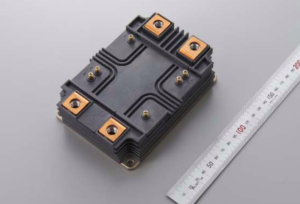Mitsubishi Electric Corporation announced today that it has developed a 6.5 kV full silicon carbide (SiC) power semiconductor module that is believed to offer the world’s highest power density (calculated from rated voltage and current) among power semiconductor modules rated from 1.7 kV to 6.5 kV. The unprecedented power density is made possible by the model’s original structure with integrated metal-oxide-semiconductor field-effect transistor (MOSFET) and diode on single chip and its newly developed package. Mitsubishi Electric expects the module to lead to smaller and more energy-efficient power equipment for high-voltage railcars and electric power systems. Going forward, the company will continue to further develop the technology and conduct further reliability tests.

Prototype of 6.5 kV full-SiC power semiconductor module
Features
1) Highest rated voltage in full-SiC modules should lead to smaller and more efficient power electronics equipment
– 6.5 kV rated voltage is highest among silicon insulated-gate bipolar transistor (IGBT) power semiconductor modules
– Full-SiC technology improves power density and efficiency and enables higher operating frequencies for smaller and more energy-efficient high-voltage power electronics equipment
2) Original one-chip structure and new package for high heat dissipation and high heat tolerance
– Chip area reduced drastically thanks to integrating MOSFET and diode on single chip
– Insulating substrate with superior thermal properties and reliable die bonding technology facilitate heat dissipation and heat tolerance
– 9.3 kVA/cm3 power density is world’s highest among power semiconductor modules rated from 1.7 kV to 6.5 kV
Details
Mitsubishi Electric’s SiC power semiconductor modules cover a full range of rated voltages, including its new full-SiC power module rated at 6.5 kV, tops among silicon IGBT power semiconductor modules.
Conventionally, power circuits use two power semiconductor modules connected in series, which requires high voltage in excess of the modules’ rated voltages. The new single module with a higher rated voltage significantly simplifies the circuit. Also, replacing silicon IGBT modules with full-SiC modules substantially reduces switching loss. In addition, the circuit’s operating frequency can be increased to allow smaller peripheral components, leading to more compact equipment.
Conventional power semiconductor modules use two separate semiconductor chips, one with a MOSFET and the other with a diode. Mitsubishi Electric has integrated the diode in the MOSFET chip to drastically reduce the power module’s footprint. In addition, a new insulating substrate capable of high thermal conductivity and high heat tolerance has been adopted, the result of a cooperative effort involving four material manufacturers. Bonding with the insulating substrate is achieved with Mitsubishi Electric’s own reliable technology.
Other Features
The new full-SiC power module will be compatible with Mitsubishi Electric’s HV100 series silicon IGBT modules.
Power electronics equipment is used widely in consumer appliances, industrial machinery and railcars, all of which are trending toward higher energy efficiency, reduced sizes and high voltages. Mitsubishi Electric is replacing its conventional silicon power semiconductor modules with more energy-efficient SiC power semiconductor modules as key components for power electronics equipment.
Previously, the company commercialized a traction inverter using 3.3 kV full-SiC power semiconductor modules for railcars in 2013. Mitsubishi Electric’s development of a 6.5 kV full-SiC power module has been supported by a project that is subsidized by the New Energy and Industrial Technology Development Organization (NEDO). Participants in the project, in addition to the four abovementioned material manufacturers (DOWA Electronics Materials Co. Ltd., Mitsubishi Materials Corp., Denka Co. Ltd., and Japan Fine Ceramics Co. Ltd.), also involves three universities (Tokyo Institute of Technology, Shibaura Institute of Technology, and Kyushu Institute of Technology) and one public research institute (National Institute of Advanced Industrial Science and Technology).
Pending patents for the technology announced in this news release number nine in Japan and three outside of Japan.
Source: http://www.mitsubishielectric.com
As an Expert in High Performance Coaching, Kaitlyn brings fresh news about Wearable Techs and Sport Innovation. She is now contributor at Athis News.




































